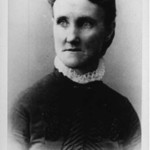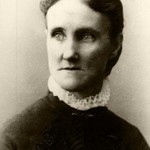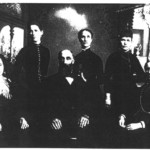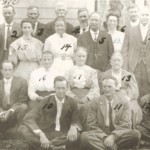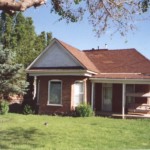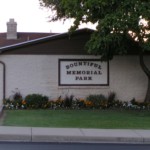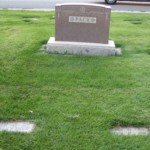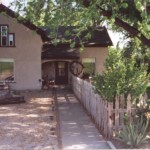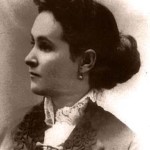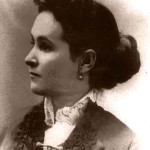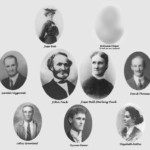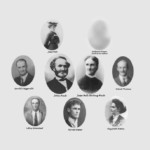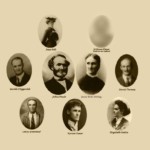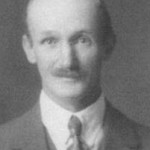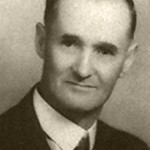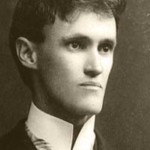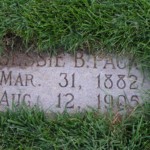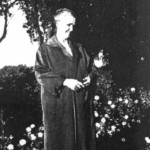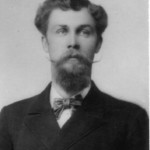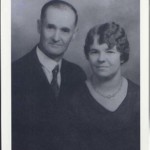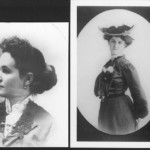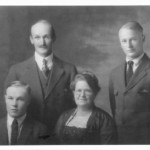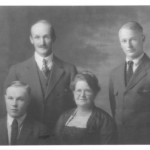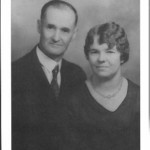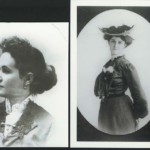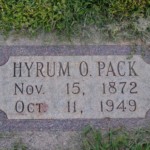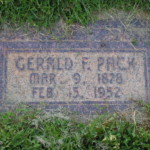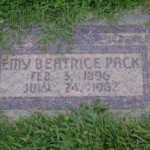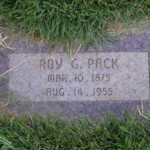Jessie Belle Stirling Pack (her own story)
On Sunday, Nov. 1, 1924, May P. Ingham, Pearl P. Taylor, Eliza Pack and Mary Pack
went up from Salt Lake to Woods Cross to see Aunt Jessie, one of Grandfather John
Pack’s wives, to get her to talk, if she would, of the past, so that they might put it on
record. Aunt Jessie seemed young and alert at that time; her voice was hearty and ringing as she welcomed her visitors; one could scarcely believe her to be 79 years of age, but she was born in 1845, she said.
She was willing to talk of the past “if she could remember,” and she said in part:
“I was born in the old country in 1845, on Sept. 26, and I lived with my people in
Forfarshire, Dundee, Scotland, until I was sixteen years of age, when I emigrated to Utah with others from that part. My father was Scotch, and his name was Thomas Stirling. He was born, probably, about 1808. My mother was English, and her name was Elizabeth Bell. I think she was born in 1811. At any rate, she was born the same year that Queen Victoria was. I remember her saying that often.
“We heard and accepted the gospel in Scotland. Previous to that we were
Presbyterians, but as soon as my father heard Mormonism, he was convinced and was
baptized. The rest of the family all accepted the Gospel after that. I was baptized when I
was thirteen. I think we first heard the gospel through a man by the name of Gilles who
lived in Dundee. He came over to Forfarshire with two missionaries and they held
meetings there. My father, after he joined the Church, was president of the branch in
Forfarshire. In this branch at that time were Sister Ramsey and Young, two to us
every night. We were all religious.old ladies, our own family, and one or two others.
We used to held meetings in our house.
“My father was a very religious man. I remember that he used to read the Bible to us every night. We were all religious.
“I was baptized when I was thirteen, in Scotland, in the Loch. (Loch stands for lake of
fresh water). I was baptized one Sunday night by moonlight—probably on account of the opposition. I remember they used to call me “Mormon Jessie” then, but I didn’t care. An Elder, by the name of Baxter, I think baptized me. He came to our place from Utah. I
remember that I used to black his shoes when he would come Saturday nights, for him to wear on Sunday.
“I came to Utah when I was sixteen, and I was the only one in our family who came
at that time. My aunt, my father’s sister, pleaded with me to stay and she offered me a
good home with her—she was quite wealthy. I remember that she felt badly about my
leaving and that she cried all night. But I felt that I just had to come, and all her pleading
did no good. She told me that I would come out here and Brigham Young would want me for his wife, but I just laughed at that.
2
“I never would have come to Utah if I hadn’t had such a strong testimony of the gospel. My aunt begged me so hard to stay. She had no children of her own, and she wanted me to be with her. I said, ‘I can’t stay. I’ve got to go!’
“The company I came with was in charge of Elder Ben E. Rich and Elder Francis M. Lyman. Brother Lyman was 21 at that time, and he was married. Their fathers, Brother Charles C. Rich and Brother Amasa Lyman were with us, too; but at Liverpool they left us and went ahead of us on a steamer. By the time we got to Liverpool, there were 800 in the company. We came on the ‘William Tapscot’, a sailing vessel, and it took us six weeks and two days to cross. Apostles Rich and Lyman, who were sailing on the steamer, passed us on the water and went ahead of us.
“When we were out on the sea one night, we had a terrible storm. We didn’t know but what we were all going to the bottom. Brother Lyman and Brother Rich walked up and down the deck, one on each side of the ship, talking to us and telling us that we would be alright, and I tell you they were not afraid to work! In the morning, the storm had broken up, and it was the most beautiful day I ever saw, and we all went upon deck, and we held a meeting. The captain in charge of the vessel was the first to speak. He said, ‘I am going to call you Brothers and Sisters because I tell you these brethren have saved this vessel,’ and he told us that we had been blown back 300 (?) miles that night, and if it had not been a Mormon vessel, he said it surely would have gone to the bottom.
“Yes, there were 800 people on that vessel, and when the Captain spoke he was addressing 800 people. There were only Mormons on the ship beside the crew. He said he was sure that it was through the faith of those people that our ship had been saved.
“The rest of the journey was uneventful. Stinking water was the only drawback.
“The ship came in at Castle Gardens, New York, and we had to file out while two men looked us over and passed us through, two by two. The captain said, ‘Oh, this is a clean company. You don’t need to bother.’
“After that was over, we traveled nine days and nine nights in cattle cars to St. Joseph, Missouri. These cars were all closed and locked, and we had to lie down at night just as we could, feet to feet, and head to head. The train crew thrust their lanterns through the window and said, ‘Oh, this is the way Mormons travel-four a bed.’
“St. Joseph was the awfulest feeling place I was ever in. The boat wasn’t sailing until the morning, and we had to stay in a big barn near the river over night. We had some clean clothes, and we did so want a bath. We went out walking and looking around, and we met some soldiers. When they heard we were staying in a big barn, they said that was awful and if we would come with them, they would find us a comfortable place to stay over night. We were young, of course, and inexperienced, and we thought everybody was as good as we were, and we came pretty near going with them. But Brother Rich and Brother Lyman came down and saw us with these men, and they motioned for us, but you can just see what such things might have led to.
3
“We were on the boat two days and two nights from St. Joseph and we landed at Council Bluffs. We tried again to get a bath at Council Bluffs. We started out there, but the sky got all black. I said to the girls, ‘We got to get back.’ We were quite a little way from our tents and luggage. Before we could reach them, it commenced to rain, and for all the storms you ever saw! We had no shelter as the tents weren’t up then, so we just had to duck under the canvas and hold it up over our heads. During an awful crash, I looked out. Two men were talking over their tents and luggage and when the lightning struck, they fell. It didn’t storm very long, and when it had stopped, I rushed out. I had some olive oil, and I poured it on one man. His neck was all blistered. Pretty soon he was better, but the other man was dead. Then, soon afterwards I found that my feet were all blistered. The next day they swelled way up, and after that I was in bed for a week with them. Even now, when it storms, it affects my feet and makes them swell and ache.
“We stayed in Council Bluffs for three weeks waiting for the ox teams to come for us. They were teams from Utah that were sent across the plains for us. We left Council Bluffs May 15, 1862, and arrived in Salt Lake Oct. 20, 1862, after traveling all the time. We would travel all day on the plains and if we could not get to water, we would travel all night. When we would camp, we would gather up buffalo chips, and wood, where we could, and build our fire and cook a little bacon. Then the boys would get their fiddles and we would clear off the sage brush, and dance. We sang Scotch songs, then we would sing hymns and have prayers and go to bed. We had to make our beds right on the ground, and if, in the morning when we woke up, there was a snake in bed with us, we’d just kick it out.
“Brother Horton Haight was Captain of the Company, and Ward E. Pack, Sr. was Assistant Captain. Then the company was divided into divisions of 100s, 50s, and10s, with a captain over each division. All of the 600 who crossed the ocean came on across the plains. “When we had left one camp, we had to keep on until we came to the next, for the oxen had to be fed and watered whether we were taken care of or not. One time Captain Haight said, ‘Let’s go through to the next camp. I want to visit with Captain Miller, who is ahead of us in charge of a company.’ That made fifteen miles more to go, or thirty miles altogether. It was way past midnight before we got there. Ward Pack satin one of the seats of one of the wagons. I looked up and said, ‘Ward, this is slow murder!’ and he said, ‘Well, it won’t happen any more.’ We got in the best we would, but some were unable to get to camp, and the men had to go back to them, to protect them from wild animals. They went back and found the people who were behind and stayed with them all night. We laid over the next day and rested.
“We had to cross the Platte River five times. “One day we girls said, ‘Let’s go ahead and get to the camp. We know that we could find it ahead about 15 miles.’ We walked fast and got about four miles along, and we saw Indians coming along on horses. That scared us, of course, and we started running back to the oxen. When we got there, we were pretty nearly dead. We said, ‘Well, we will never
4
go against counsel again. We will never go ahead of the ox teams the rest of the trip. “Well, yes, we had plenty to wear. I had just one sun bonnet, but made that last. The men had flour and bacon and a little tea. We didn’t buy anything additional at Council Bluffs. Everybody got rations.
“We arrived in Salt Lake Oct. 20, 1862. We had to walk all up and down both sides of the streets several times to find a place where we could buy enough gingham to make a sunbonnet. Only little wooden building lined the streets with wooden windows. No more like stores!
“James Mare, who lived with his family then down by the Lion House, came down to meet me, and I went up to his place. He knew me when he was in the old country, as a missionary in Dundee. He brought me to his house and treated me fine. It was said that he was one of the smartest men to measure lumber they had ever had in this country. I stayed there a few days, but I cried all the time. Mr. Mare wanted me to get married, and I did not want to marry. Then Ward Pack came and asked me if I would like to come up and stay with his wife, Laura. So I went.
“Ward Pack was Assistant Captain, but before we got in here, Ward asked me to come and stay with them-with Aunt Laura and him-and I came and stayed with them at his little house on the corner. While I was there, John Pack, Ward’s father, came to seethe family and to see this girl who was staying with them, and in the spring he said he would like to get someone to help his wife with the cows, etc. I went over to Kamas to work for him that summer. I had left all my people in the old country, you see. Later I married John Pack.
“In Salt Lake, Ward brought us a melon; it was the first we had tasted, and we thought it was the best thing we had ever tasted. Next day we went out foraging and brought in what we thought were melons, but before we had a chance to eat them, we were informed they were merely green squash.
“The old Pack house in the Seventeenth Ward was a good house. The lumber came from Kamas. Julia, one of John Pack’s wives, lived there until taxes became so high. So long as she raised her strawberries, cucumbers, etc., she could live there, but when taxes were raised, she had to move to Kamas. She died there. She used to keep the place in Salt Lake so beautiful. She raised flowers and used to sell out flowers, in addition to garden products.”
This finished Aunt Jessie’s reminiscences about herself. There was some discussion of Grandfather John Pack. He worshipped horses, it seemed. He had one horse by the name of “Ham” that no one could manage but himself. When he was away, people had to water and feed the horse by letting buckets down through the loft, from the top. John Pack liked to travel alone<resented instructions. May Ingham recalled that at one time she had asked to ride with him. He had let her go with him, but she had had to come back on a hayrack; and as they jogged slowly along, Grandfather Pack came sailing past in his buggy alone. Aunt Jessie recalled a time when she and Agnes came to town when he
5
thought they should not have done so. He was angry, and he had the men hitch up oxen to take them home; and as they crawled along the road, he sailed past them in his buggy alone again. Aunt Jessie recalled how he brought this horse he loved up on the front porch, right through the house to the back porch one time and then said, “Now, give him a lump of sugar.”
Someone said, “Grandfather was awfully high strung, wasn’t he?”
“Oh, law,” Aunt Jessie said, “But he’d get over it!”
The horse, Ham, died when John Pack was an old man. He, himself, died just one month after. Some said it was the horse’s death that hastened his own.
John Pack was French and Low Dutch. Low refers to the country from which his people came. Possibly he claimed this descent from his mother, as records show his own folks were English. Aunt Jessie said his mother looked Dutch to her. She was a little woman.
When the first pioneers came to Utah, Brigham Young was taken ill up in the canyon, and he sent five men down to see what they could find. Three came back and one of the five was John Pack. On the monument on Main Street and South Temple, and also, on the monument at the mouth of Emigration Canyon, John Pack is given credit as being one of the first five pioneer men to enter the valley.
from Corliss Clayton June 2009
